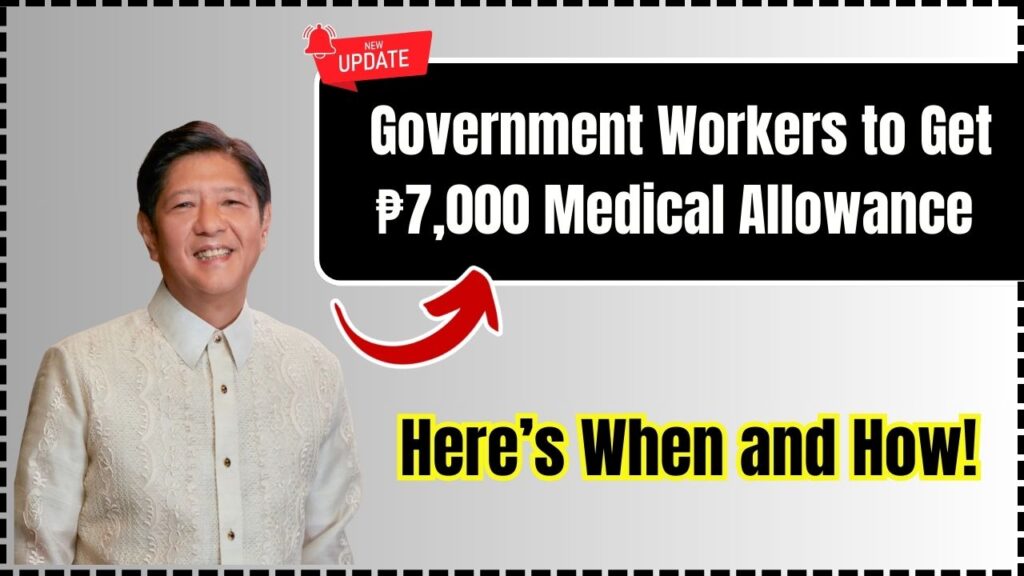Government Workers to Get ₱7,000 Medical Allowance: In a landmark decision designed to improve the welfare of government employees, the Philippine government has unveiled a ₱7,000 medical allowance for eligible public servants. This substantial initiative, which becomes effective starting January 1, 2025, reflects the state’s recognition of the vital role that civil servants play in the nation’s progress and its commitment to prioritizing their health and well-being.

The medical allowance, introduced through Executive Order No. 64, s. 2024 and operationalized via DBM Budget Circular No. 2024-6, provides a flexible healthcare subsidy. It allows government employees to either subscribe to a Health Maintenance Organization (HMO) plan or reimburse out-of-pocket medical expenses incurred throughout the year.
This is a welcome move, especially in a time when rising healthcare costs are a burden not only for low-income families but also for middle-class professionals trying to make ends meet. It aligns with broader reforms aimed at improving employee benefits and cultivating a more empowered and health-conscious civil service.
Government Workers to Get ₱7,000 Medical Allowance
| Details | Description |
|---|---|
| Amount | ₱7,000 per year |
| Effective Date | January 1, 2025 |
| Eligibility | Civilian employees in NGAs, SUCs, GOCCs (non-GCG covered), LGUs, and LWDs |
| Coverage Options | HMO-type benefits or cash reimbursement for medical expenses |
| Tax Status | Tax-exempt as a de minimis benefit under BIR Revenue Memorandum Circular No. 107-2024 |
| Exclusions | Military, uniformed personnel, and those with HMO benefits via special laws |
| Funding Source | ₱9.5 billion from the Miscellaneous Personnel Benefits Fund (MPBF) |
| Official References | DBM Circular 2024-6 EO No. 64, s. 2024 |
In an era where inflation continues to stretch household budgets and medical expenses are increasingly unaffordable, the introduction of the ₱7,000 medical allowance is a strategic, compassionate, and empowering policy. It is more than just financial aid—it is a reflection of the government’s recognition of its people’s humanity and health as fundamental to effective public service.
For many employees, especially those who have served quietly in far-flung areas without robust healthcare systems, this allowance represents long-overdue support. It bridges health gaps, uplifts morale, and reinforces the belief that public service does not mean sacrificing personal well-being.
As the program rolls out, it will be crucial for agencies to ensure transparency, equal access, and timely disbursement. With thoughtful implementation, the medical allowance can be a cornerstone of sustainable employee welfare—and a model for future reforms in the public sector.
What is the ₱7,000 Medical Allowance?
The ₱7,000 medical allowance is a yearly financial grant intended to help government workers cover essential medical needs—either for themselves or their immediate dependents. It’s a flexible fund, meaning employees have the choice to use it toward purchasing or renewing HMO coverage or paying directly for healthcare-related expenses such as:
- Doctor consultations
- Diagnostic exams and laboratory tests
- Prescription medications
- Emergency treatments
- Preventive care
- Hospitalization costs
- The initiative aims to reduce employees’ out-of-pocket costs and make healthcare more accessible—regardless of their geographic location or income level.
Who Can Avail of the Medical Allowance?
Eligible Personnel:
The medical allowance is available to civilian government employees across various institutions, including:
- National Government Agencies (NGAs)
- State Universities and Colleges (SUCs)
- Government-Owned or -Controlled Corporations (GOCCs) not governed by the GCG
- Local Government Units (LGUs)
- Local Water Districts (LWDs)
It includes all employee types—whether regular, casual, contractual, full-time, part-time, or even those in elective or appointive positions—as long as they have completed at least six months of cumulative service within the fiscal year.
This broad eligibility ensures inclusivity and maximizes the program’s impact by benefiting employees in both frontline and administrative roles.
Who’s Not Eligible?
While the program is comprehensive, certain groups are excluded:
- Military and uniformed personnel (e.g., PNP, AFP, BFP, BJMP)
- Government employees already enjoying HMO services through special legislation
- Staff from constitutional commissions or the judiciary, who operate under fiscal autonomy
- Non-employee-based personnel, such as:
- Independent consultants
- Workers under job orders or contracts of service
- Student assistants or interns
- Laborers paid by results or project-based compensation
- These exclusions help the government focus resources on personnel with standard employer-employee relationships.
Government Workers to Get ₱7,000 Medical Allowance Claim the Medical Allowance
The Department of Budget and Management (DBM) allows agencies to adopt either of the following disbursement strategies, depending on logistics and regional needs:
Option 1: Group HMO Procurement
Agencies may choose to enroll their employees in a group HMO policy, simplifying access to a wide range of health services. Common benefits include:
- Annual physical exams
- Specialist consultations
- Emergency services
- In-patient and out-patient care
- Diagnostic testing
This option is ideal for agencies located in urban areas with access to HMO partner hospitals and clinics. Group coverage also helps ensure all employees enjoy uniform benefits.
Option 2: Direct Cash Assistance
For employees in remote or underdeveloped areas, or where HMOs are unavailable or difficult to access, the allowance can be released in cash form. This gives employees the freedom to use the funds based on their specific needs and the available healthcare services in their locality.
Covered expenses may include:
- Out-of-pocket doctor’s fees
- Diagnostic tests at local clinics
- Purchase of maintenance medications
- Payment of private medical insurance premiums
Employees should contact their HR department or agency accountant to process their claim. Documentation, such as proof of medical expenses or declarations of need, may be required for reimbursement or liquidation.
Why This Matters: A Closer Look at the Impact
The Civil Service Commission (CSC) reports over 1.8 million individuals are currently employed in the Philippine public sector. Yet, not all of them have access to affordable or high-quality healthcare. In fact, studies show that many government employees—especially those working in rural provinces and municipalities—struggle with long travel times and lack of nearby medical facilities.
The introduction of a medical allowance responds to these disparities. Here’s why it’s a game-changer:
- Consultation fees with general practitioners can range from ₱500 to ₱1,500 per visit.
- Monthly maintenance drugs for conditions like hypertension, diabetes, or asthma can easily exceed ₱2,000.
- Routine blood work and lab tests may cost between ₱3,000 and ₱5,000.
- An unexpected emergency room visit can cost upwards of ₱10,000, especially without insurance.
A medical allowance of ₱7,000 may not cover everything, but it certainly provides a financial cushion—especially for those who previously had to shoulder these costs entirely on their own.
Moreover, the flexibility of the allowance gives workers control. One employee might use it to buy antihypertensive meds, while another might apply it toward an annual physical or family check-ups. This personalization is what makes the policy not just generous, but smart.
How to Claim ₱3,400 Monthly Payment in the Philippines – Check Eligibility Criteria!
SSS Announces ₱1,976 Pension Increase Starting April 2025 – Check Payment Dates!
SSS Launches New Benefits Package: Check Grants, Pensions, and Changes in Eligibility Criteria!
FAQs On Government Workers to Get ₱7,000 Medical Allowance
Is the ₱7,000 medical allowance taxable?
No. The allowance is non-taxable as it falls under the category of de minimis benefits, as defined by the Bureau of Internal Revenue (BIR) in Revenue Memorandum Circular No. 107-2024.
Can I use it for family members’ medical needs?
Possibly. While the primary recipient is the government employee, some agencies may permit its use for immediate family members, such as dependents or spouses, particularly when disbursed in cash. Always check with your HR department.
When will the allowance be released?
It will begin rollout in January 2025. Each agency will develop its own implementation schedule and mechanism.
Is there a cut-off or deadline for eligibility?
Yes. Employees must have completed a minimum of 6 months of service within the fiscal year to qualify. Late hires in the latter half of the year may not be eligible for the full amount.
Who do I contact for questions or help?
For clarifications, contact your Human Resources or Administrative Services Office. You can also consult the DBM website for official circulars and updates.








